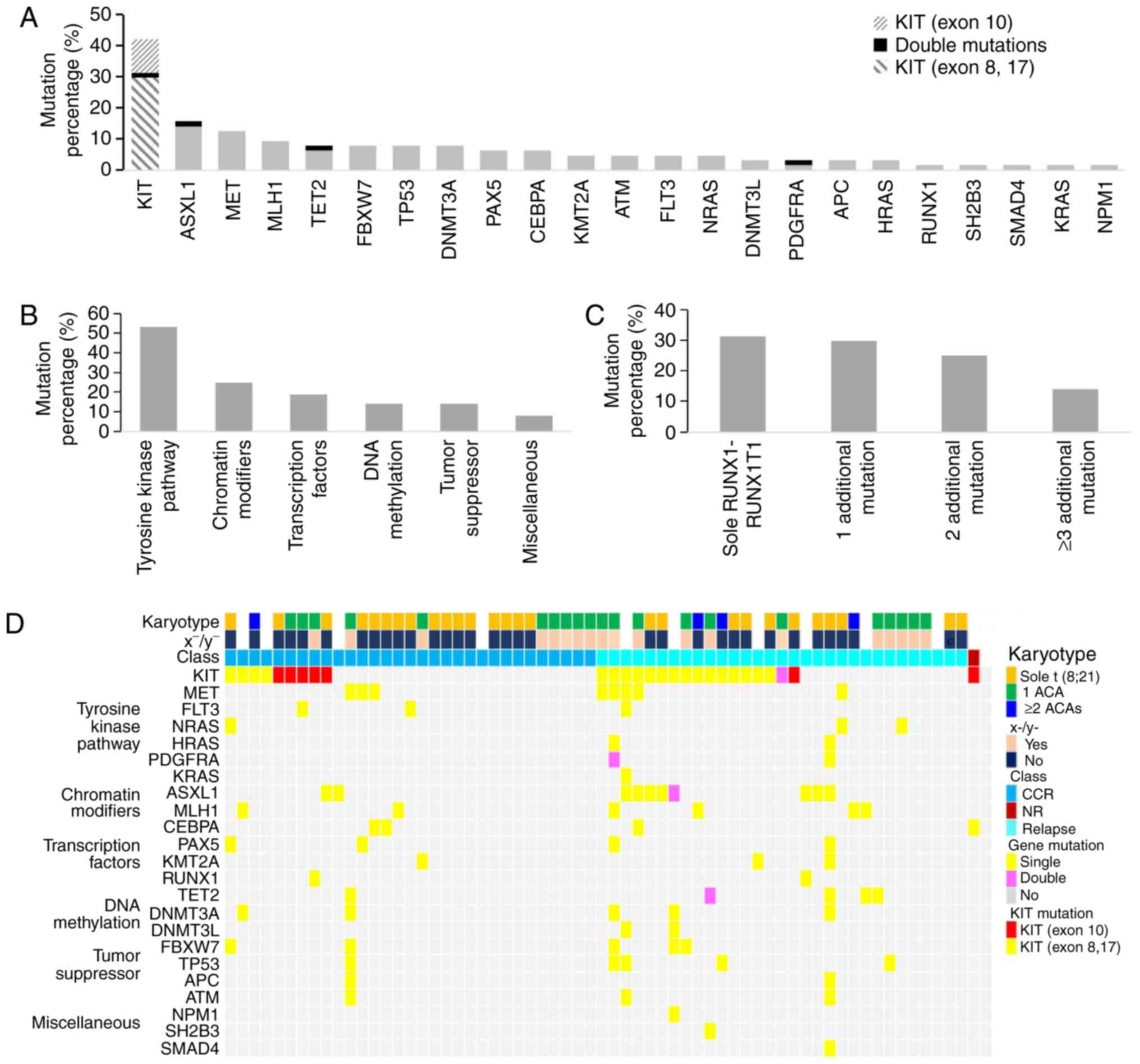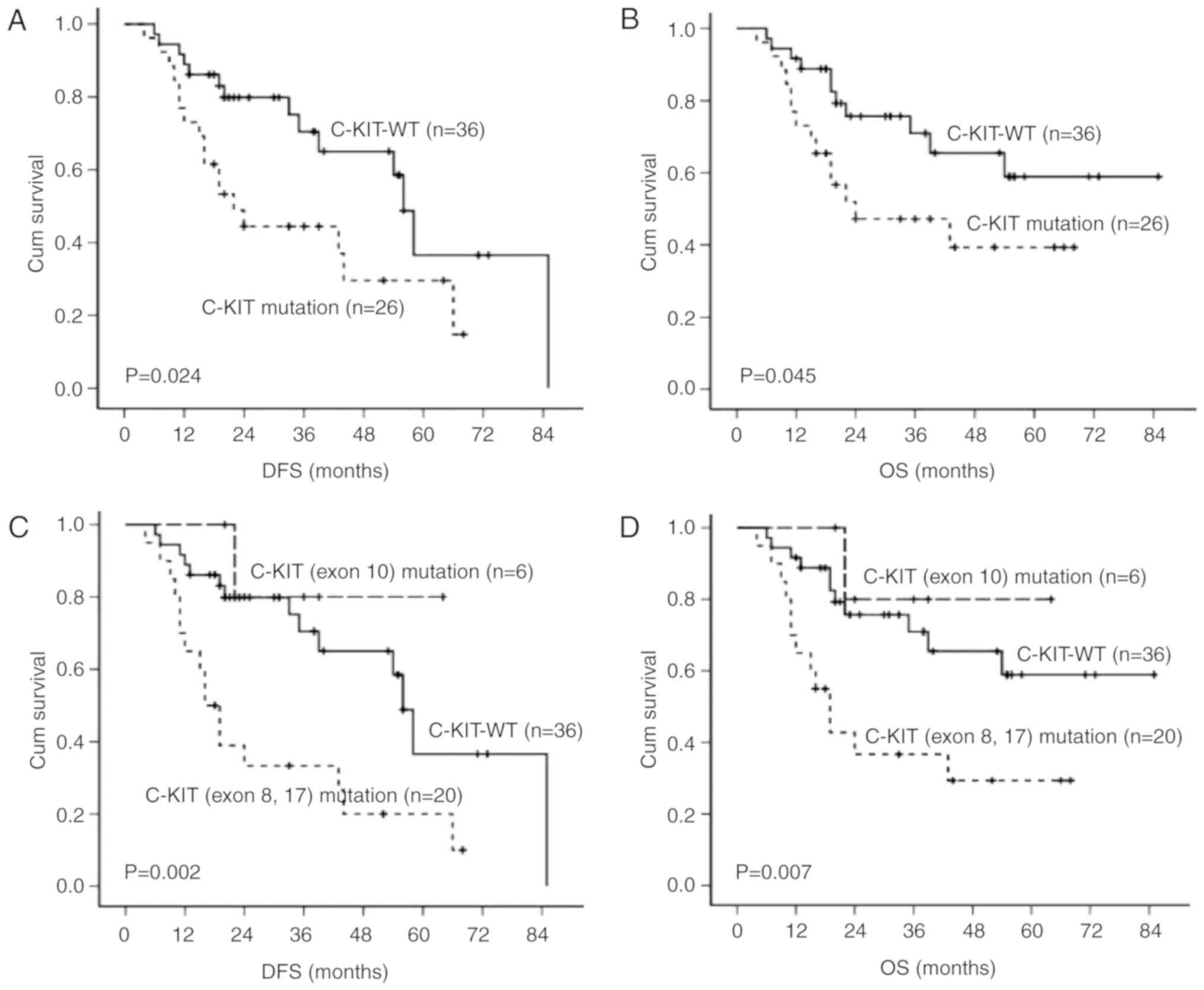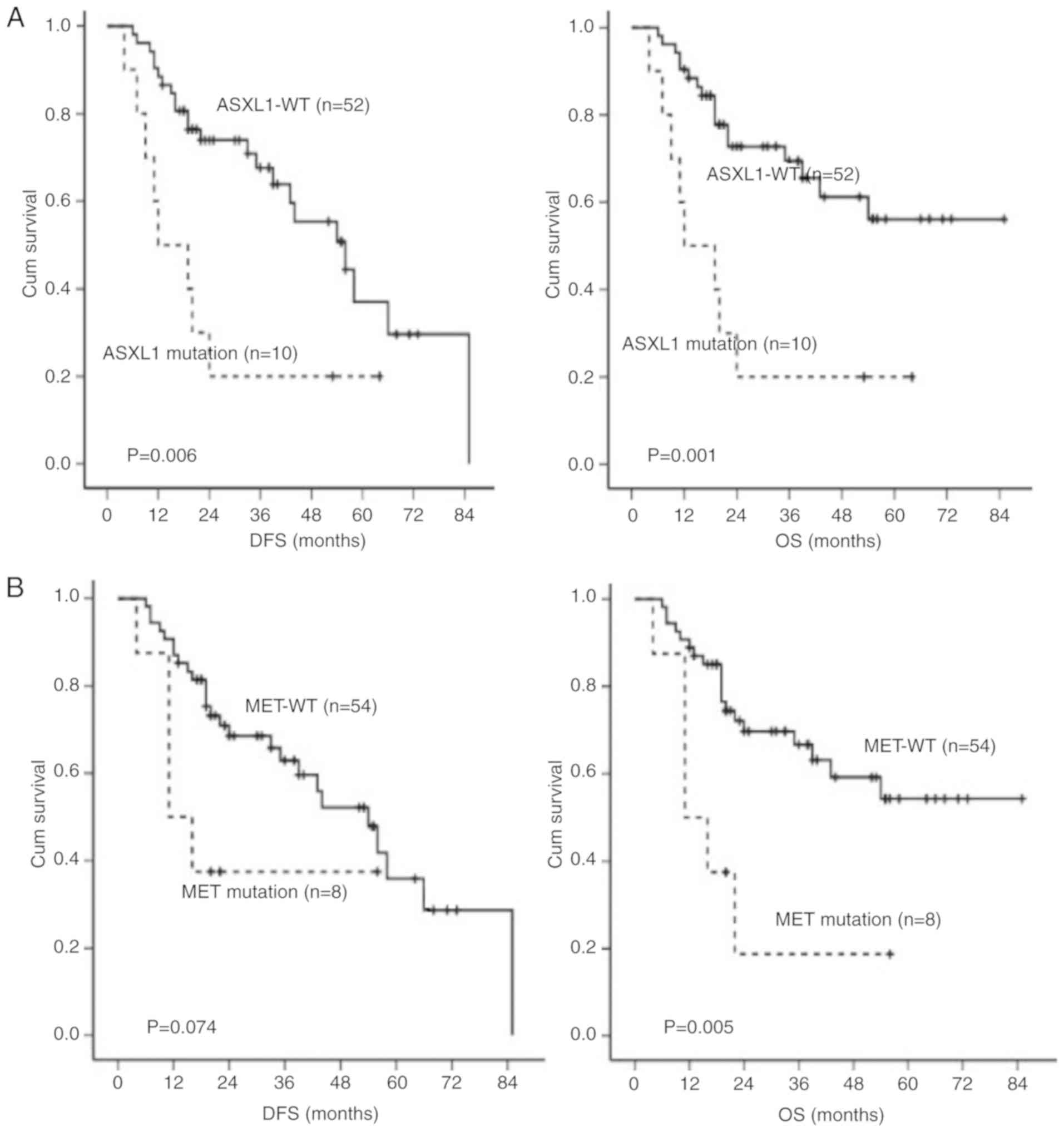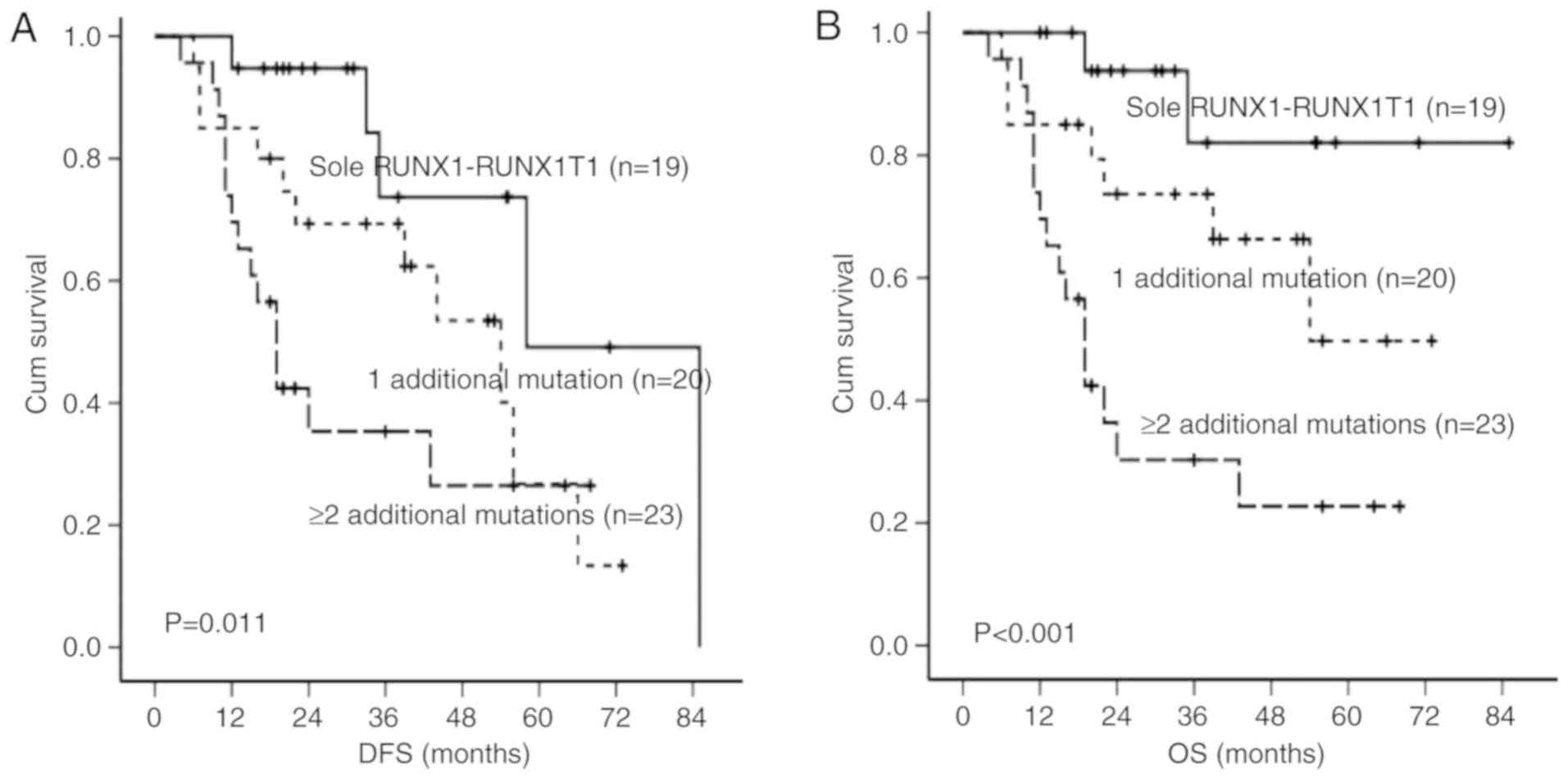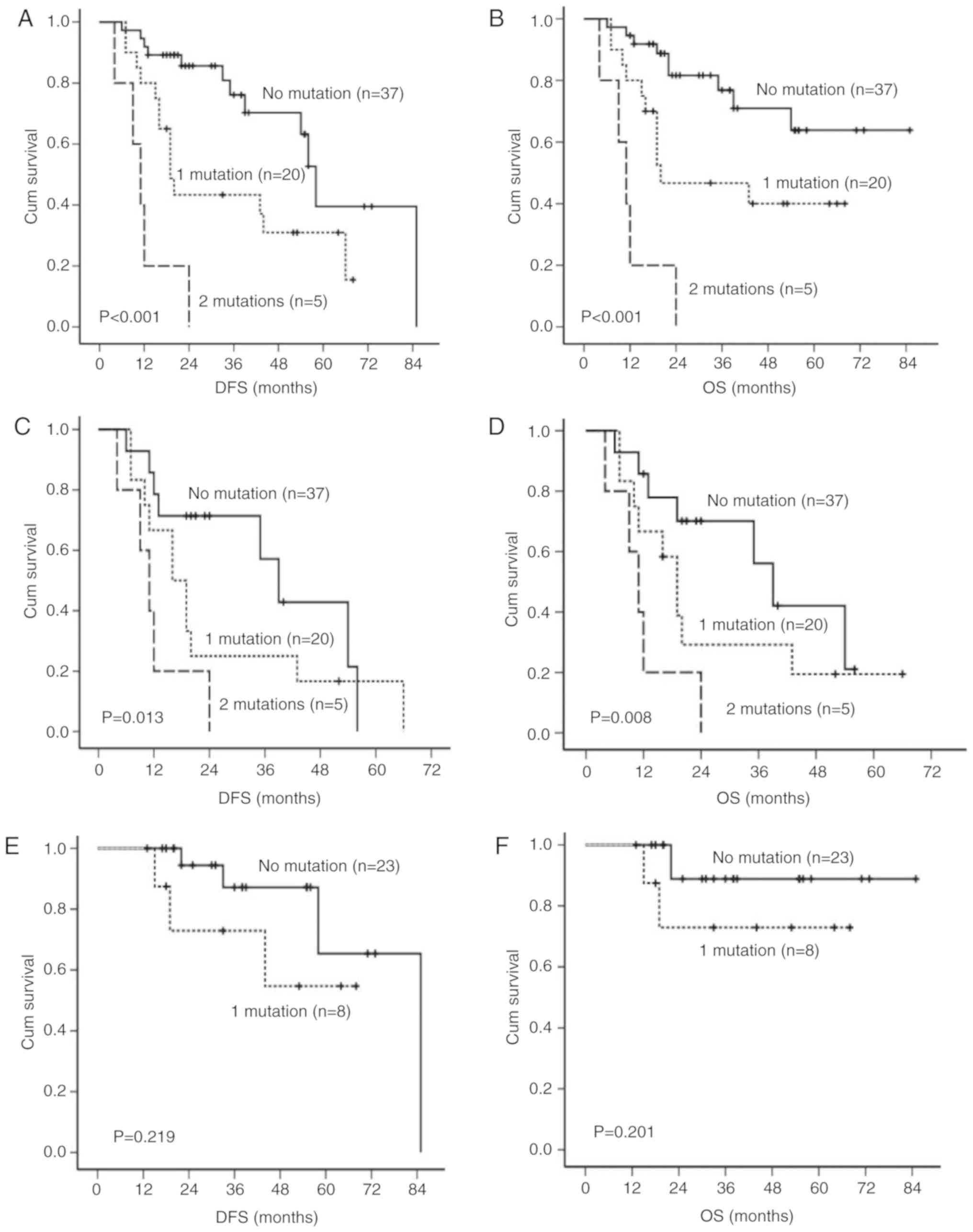|
1
|
Park SH, Chi HS, Cho YU, Jang S and Park
CJ: Effects of c-KIT mutations on expression of the RUNX1/RUNX1T1
fusion transcript in t(8;21)-positive acute myeloid leukemia
patients. Leuk Res. 37:784–789. 2013. View Article : Google Scholar : PubMed/NCBI
|
|
2
|
Arber DA, Orazi A, Hasserjian R, Thiele J,
Borowitz MJ, Le Beau MM, Bloomfield CD, Cazzola M and Vardiman JW:
The 2016 revision to the world health organization classification
of myeloid neoplasms and acute leukemia. Blood. 127:2391–2405.
2016. View Article : Google Scholar : PubMed/NCBI
|
|
3
|
Wang YY, Zhou GB, Yin T, Chen B, Shi JY,
Liang WX, Jin XL, You JH, Yang G, Shen ZX, et al: AML1-ETO and
C-KIT mutation/overexpression in t(8;21) leukemia: Implication in
stepwise leukemogenesis and response to Gleevec. Proc Natl Acad Sci
USA. 102:1104–1109. 2005. View Article : Google Scholar : PubMed/NCBI
|
|
4
|
Krauth MT, Eder C, Alpermann T, Bacher U,
Nadarajah N, Kern W, Haferlach C, Haferlach T and Schnittger S:
High number of additional genetic lesions in acute myeloid leukemia
with t(8;21)/RUNX1-RUNX1T1: Frequency and impact on clinical
outcome. Leukemia. 28:1449–1458. 2014. View Article : Google Scholar : PubMed/NCBI
|
|
5
|
Wang YY, Zhao LJ, Wu CF, Liu P, Shi L,
Liang Y, Xiong SM, Mi JQ, Chen Z, Ren R and Chen SJ: C-KIT mutation
cooperates with full-length AML1-ETO to induce acute myeloid
leukemia in mice. Proc Natl Acad Sci USA. 108:2450–2455. 2011.
View Article : Google Scholar : PubMed/NCBI
|
|
6
|
Kim M, Kim J, Kim JR, Han E, Park J, Lim
J, Kim Y, Han K, Kim HJ, Min WS and Cho B: FLT3 expression and IL10
promoter polymorphism in acute myeloid leukemia with RUNX1-RUNX1T1.
Mol Biol Rep. 42:451–456. 2015. View Article : Google Scholar : PubMed/NCBI
|
|
7
|
Grisolano JL, O'Neal J, Cain J and
Tomasson MH: An activated receptor tyrosine kinase, TEL/PDGFbetaR,
cooperates with AML1/ETO to induce acute myeloid leukemia in mice.
Proc Natl Acad Sci USA. 100:9506–9511. 2003. View Article : Google Scholar : PubMed/NCBI
|
|
8
|
Nishida S, Hosen N, Shirakata T, Kanato K,
Yanagihara M, Nakatsuka S, Hoshida Y, Nakazawa T, Harada Y, Tatsumi
N, et al: AML1-ETO rapidly induces acute myeloblastic leukemia in
cooperation with the Wilms tumor gene, WT1. Blood. 107:3303–3312.
2006. View Article : Google Scholar : PubMed/NCBI
|
|
9
|
Duncavage EJ and Tandon B: The utility of
next-generation sequencing in diagnosis and monitoring of acute
myeloid leukemia and myelodysplastic syndromes. Int J Lab Hematol.
37 (Suppl 1):115–121. 2015. View Article : Google Scholar : PubMed/NCBI
|
|
10
|
Dunlap J, Beadling C, Warrick A, Neff T,
Fleming WH, Loriaux M, Heinrich MC, Kovacsovics T, Kelemen K,
Leeborg N, et al: Multiplex high-throughput gene mutation analysis
in acute myeloid leukemia. Hum Pathol. 43:2167–2176. 2012.
View Article : Google Scholar : PubMed/NCBI
|
|
11
|
Cher CY, Leung GM, Au CH, Chan TL, Ma ES,
Sim JP, Gill H, Lie AK, Liang R, Wong KF, et al: Next-generation
sequencing with a myeloid gene panel in core-binding factor AML
showed KIT activation loop and TET2 mutations predictive of
outcome. Blood Cancer J. 6:e4422016. View Article : Google Scholar : PubMed/NCBI
|
|
12
|
Yin CX, Wu FQ, Cao R, Jiang XJ, Yu GP, He
H and Meng FY: Preliminary application of Ion Torrent PGM™
sequencing technology in the diagnosis of acute myeloid leukemia.
Chin J Clin Lab Sci. 33:333–336. 2015.(In Chinese).
|
|
13
|
Yu G, Yin C, Jiang L, Zheng Z, Wang Z,
Wang C, Zhou H, Jiang X, Liu Q and Meng F: Amyloid precursor
protein cooperates with c-KIT mutation/overexpression to regulate
cell apoptosis in AML1-ETO-positive leukemia via the PI3K/AKT
signaling pathway. Oncol Rep. 36:1626–1632. 2016. View Article : Google Scholar : PubMed/NCBI
|
|
14
|
Yu G, Yin C, Jiang L, Xu D, Zheng Z, Wang
Z, Wang C, Zhou H, Jiang X, Liu Q and Meng F: Amyloid precursor
protein has clinical and prognostic significance in
AML1-ETO-positive acute myeloid leukemia. Oncol Lett. 15:917–925.
2018.PubMed/NCBI
|
|
15
|
Zhu HH, Zhang XH, Qin YZ, Liu DH, Jiang H,
Chen H, Jiang Q, Xu LP, Lu J, Han W, et al: MRD-directed risk
stratification treatment may improve outcomes of t(8;21) AML in the
first complete remission: Results from the AML05 multicenter trial.
Blood. 121:4056–4062. 2013. View Article : Google Scholar : PubMed/NCBI
|
|
16
|
Yuan Y, Zhou L, Miyamoto T, Iwasaki H,
Harakawa N, Hetherington CJ, Burel SA, Lagasse E, Weissman IL,
Akashi K, et al: AML1-ETO expression is directly involved in the
development of acute myeloid leukemia in the presence of additional
mutations. Proc Natl Acad Sci USA. 98:10398–10403. 2001. View Article : Google Scholar : PubMed/NCBI
|
|
17
|
de Guzman CG, Warren AJ, Zhang Z, Gartland
L, Erickson P, Drabkin H, Hiebert SW and Klug CA: Hematopoietic
stem cell expansion and distinct myeloid developmental
abnormalities in a murine model of the AML1-ETO translocation. Mol
Cell Biol. 22:5506–5517. 2002. View Article : Google Scholar : PubMed/NCBI
|
|
18
|
Conway O'Brien E, Prideaux S and Chevassut
T: The epigenetic landscape of acute myeloid leukemia. Adv Hematol.
2014:1031752014.PubMed/NCBI
|
|
19
|
Duployez N, Marceau-Renaut A, Boissel N,
Petit A, Bucci M, Geffroy S, Lapillonne H, Renneville A, Ragu C,
Figeac M, et al: Comprehensive mutational profiling of core binding
factor acute myeloid leukemia. Blood. 127:2451–2459. 2016.
View Article : Google Scholar : PubMed/NCBI
|
|
20
|
Qin YZ, Zhu HH, Jiang Q, Jiang H, Zhang
LP, Xu LP, Wang Y, Liu YR, Lai YY, Shi HX, et al: Prevalence and
prognostic significance of c-KIT mutations in core binding factor
acute myeloid leukemia: A comprehensive large-scale study from a
single Chinese center. Leuk Res. 38:1435–1440. 2014. View Article : Google Scholar : PubMed/NCBI
|
|
21
|
Schnittger S, Kohl TM, Haferlach T, Kern
W, Hiddemann W, Spiekermann K and Schoch C: KIT-D816 mutations in
AML1-ETO-positive AML are associated with impaired event-free and
overall survival. Blood. 107:1791–1799. 2006. View Article : Google Scholar : PubMed/NCBI
|
|
22
|
Micol JB, Duployez N, Boissel N, Petit A,
Geffroy S, Nibourel O, Lacombe C, Lapillonne H, Etancelin P, Figeac
M, et al: Frequent ASXL2 mutations in acute myeloid leukemia
patients with t(8;21)/RUNX1-RUNX1T1 chromosomal translocations.
Blood. 124:1445–1449. 2014. View Article : Google Scholar : PubMed/NCBI
|
|
23
|
Zenali M, deKay J, Liu Z, Hamilton S, Zuo
Z, Lu X, Bakkar R, Mills G and Broaddus R: Retrospective review of
MET gene mutations. Oncoscience. 2:533–541. 2015. View Article : Google Scholar : PubMed/NCBI
|
|
24
|
Johnson J, Ascierto ML, Mittal S, Newsome
D, Kang L, Briggs M, Tanner K, Marincola FM, Berens ME, Vande Woude
GF and Xie Q: Genomic profiling of a hepatocyte growth
factor-dependent signature for MET-targeted therapy in
glioblastoma. J Transl Med. 13:3062015. View Article : Google Scholar : PubMed/NCBI
|
|
25
|
Park WS, Dong SM, Kim SY, Na EY, Shin MS,
Pi JH, Kim BJ, Bae JH, Hong YK, Lee KS, et al: Somatic mutations in
the kinase domain of the Met/hepatocyte growth factor receptor gene
in childhood hepatocellular carcinomas. Cancer Res. 59:307–310.
1999.PubMed/NCBI
|
|
26
|
Graeber TG and Eisenberg D: Bioinformatic
identification of potential autocrine signaling loops in cancers
from gene expression profiles. Nat Genet. 29:295–300. 2001.
View Article : Google Scholar : PubMed/NCBI
|
|
27
|
Zheng R, Klang K, Gorin NC and Small D:
Lack of KIT or FMS internal tandem duplications but co-expression
with ligands in AML. Leuk Res. 28:121–126. 2004. View Article : Google Scholar : PubMed/NCBI
|
|
28
|
McGee SF, Kornblau SM, Qiu Y, Look AT,
Zhang N, Yoo SY, Coombes KR and Kentsis A: Biological properties of
ligand-dependent activation of the MET receptor kinase in acute
myeloid leukemia. Leukemia. 29:1218–1221. 2015. View Article : Google Scholar : PubMed/NCBI
|
|
29
|
Soussi T, Legros Y, Lubin R, Ory K and
Schlichtholz B: Multifactorial analysis of p53 alteration in human
cancer: A review. Int J Cancer. 57:1–9. 1994. View Article : Google Scholar : PubMed/NCBI
|
|
30
|
Stengel A, Kern W, Haferlach T,
Meggendorfer M, Fasan A and Haferlach C: The impact of TP53
mutations and TP53 deletions on survival varies between AML, ALL,
MDS and CLL: An analysis of 3307 cases. Leukemia. 31:705–711. 2017.
View Article : Google Scholar : PubMed/NCBI
|
|
31
|
Hou HA, Chou WC, Kuo YY, Liu CY, Lin LI,
Tseng MH, Chiang YC, Liu MC, Liu CW, Tang JL, et al: TP53 mutations
in de novo acute myeloid leukemia patients: Longitudinal follow-ups
show the mutation is stable during disease evolution. Blood Cancer
J. 5:e3312015. View Article : Google Scholar : PubMed/NCBI
|
|
32
|
Wattel E, Preudhomme C, Hecquet B,
Vanrumbeke M, Quesnel B, Dervite I, Morel P and Fenaux P: p53
mutations are associated with resistance to chemotherapy and short
survival in hematologic malignancies. Blood. 84:3148–3157. 1994.
View Article : Google Scholar : PubMed/NCBI
|
|
33
|
Li J, Yang L, Gaur S, Zhang K, Wu X, Yuan
YC, Li H, Hu S, Weng Y and Yen Y: Mutants TP53 p.R273H and p.R273C
but not p.R273G enhance cancer cell malignancy. Hum Mutat.
35:575–584. 2014. View Article : Google Scholar : PubMed/NCBI
|
|
34
|
Krejci O, Wunderlich M, Geiger H, Chou FS,
Schleimer D, Jansen M, Andreassen PR and Mulloy JC: p53 signaling
in response to increased DNA damage sensitizes AML1-ETO cells to
stress-induced death. Blood. 111:2190–2199. 2008. View Article : Google Scholar : PubMed/NCBI
|















